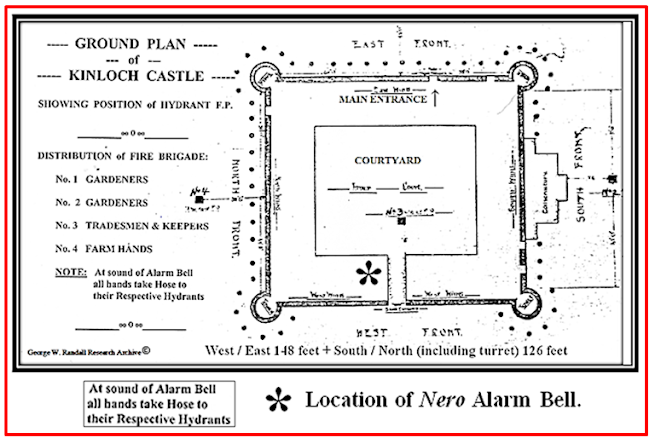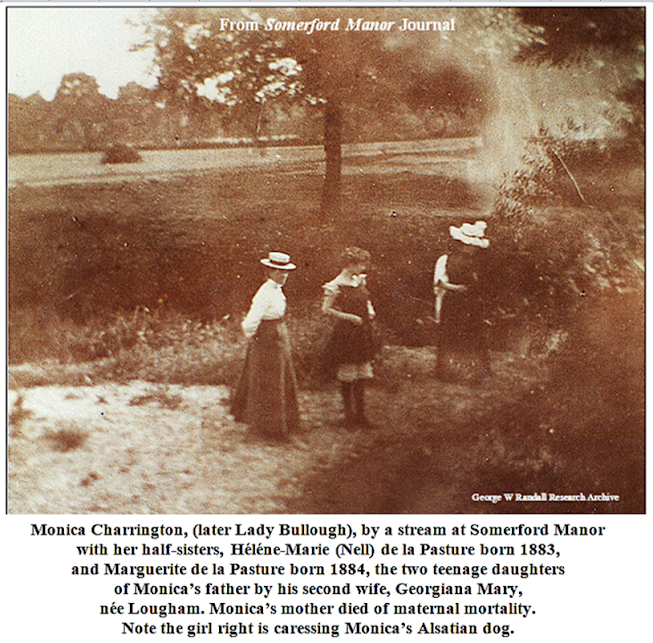KINLOCH CASTLE
SOME MYSTERIES SOLVED
First hand research and photographs © George W. Randall Archive
IS THE CHASSIS IN LOCH SCRESORT
THE REMAINS OF SIR GEORGE BULLOUGH'S
RACING CAR?
There is no evidence of a racing car or indeed a Rolls Royce!
But there is evidence the chassis possibly belonged to a Leyland truck or
a car belonging to Robert Morrison (sitting in the front of the picture below)
who was employed as engineer / blacksmith on Rum from 1911
until his retirement in 1930.
The vehicle's twelve spoke wheels have solid rubber tyres and a hub which compare favourably with the chassis in Loch Scresort.
(Photograph and historic detail supplied by Fiona Stewart. 2007.)
... ... ...
This two page article appeared in a 2002 edition of the Kinloch Castle Friends' Association Newsletter before it was considered "of little value" by a person who should have known better and production was stopped ... ... ...
The photograph below recently came to light and comparison of the wheel, hub, spokes and solid tyre, together with the owner's name, George Bullough's company, Howard & Bullough, Ltd., Accrington, (H. & B.), strongly suggest it is the remains of this or a similar vehicle that rests today in Loch Scresort.
The wheel spokes suggest a Trojan van.
In their quote dated 24 March 1926 The Royal Insurance Company Ltd., 48, St. James' Street Piccadilly, London, quoted ₤150 to insure “a Trojan, Tools, Utensils."
"The total sum insured was ₤18,660."
* * * * * * * * * * * * *
AND THE BLOCK OF STONE
INSCRIBED 1897?
This large
sandstone block depicts the year construction of Kinloch Castle commenced and when photographed stood under the glazed verandah which encircles three sides of the square castellated building close to the main entrance.
Clearly at some point it was part of the
structure
but where, and
why was it removed?
Construction of
Kinloch Castle commenced in the summer of 1897 and was completed in late 1900.
I
believe it was originally sited within the entrance archway and replaced with a
similar block bearing George Bullough’s Coat of Arms following his knighthood
on 11 December 1901 by King Edward VII for placing his yacht, Rhouma,
“at the
disposal of Queen Victoria's forces for use as a hospital ship and recruiting
station” in Table Bay, Cape Town during the first year of the Boer War which
had broken out on Wednesday 11 October 1899.
 |
| The 1897 was originally sited within the entrance archway, it was removed and replaced with the Coat of Arms of Sir George Bullough following his knighthood in 1901. |
George
Bullough sailed with his Rhouma overseeing the erection of a framed canvas
deck-house as a twenty bed ward on the aft deck, provision of bedsteads,
bedding, water tanks, baths and all food items. Two members of his crew were
sent to assist the army staff at the nearby Rondebosch Hospital.
Other crew
members helped entertain the recuperating patients on board with deck games,
music, stories, fishing and trips round the bay.
During her time at Cape
Town 216 men and forty-six officers were treated on board, there were no
fatalities.
The
Knight Bachelor citation records the thanks of “a grateful nation for his
patriotism which had helped alleviate so much pain and suffering
amongst
British troops.”
*
In the photograph below the Duke and Duchess of Rothesay stand below the
Bullough Coat of Arms at the entrance to Kinloch Castle
during their visit, 1 June 2006.
 |
| Photograph credit: Douglas King. |
Photograph credit: Douglas King.
* ** * .................................* ** *................................* ** *
ORIGIN OF THE STONE USED IN CONSTRUCTION OF KINLOCH CASTLE
For a number of years there was running debate as to the
location of the sandstone used in the construction of Kinloch Castle. In 2009,
as part of the west facing Oriel window restoration, samples were sent to the
British Geological Survey for cross matching to the two possible quarries,
Corrie on the Isle of Arran and Corsehill, near Annan, Dumfriesshire.
The
result states
“the red Triassic sandstone sample was quarried on Arran.”
However, the two upper floors on the castle’s west side, which include the Oriel windows, were an addition in 1906, not part of the original 1897-1900 construction.
No sample of the original 1897-1900 stone has been analysed.
ADDITION TO WEST WING 1906
Taken in conjunction with a note
accompanying the 1903 Geological Survey map of Arran which states that a “mansion
on Rhum” was built of Arran sandstone, it would seem to confirm Kinloch Castle is built of red sandstone that originated on the island of Arran, although it was considered not suitable in "a seaside location."
East façade of Kinloch Castle
with the Bullough Coat of Arms above principal entrance arch beneath tower.
* * * * * * * * * * * *
< + >< + >< + >< + >< + >< + >< + >< + >
LINK TO THIS BLOG POST:
ADDED MATERIAL 13 OCTOBER 2024


































